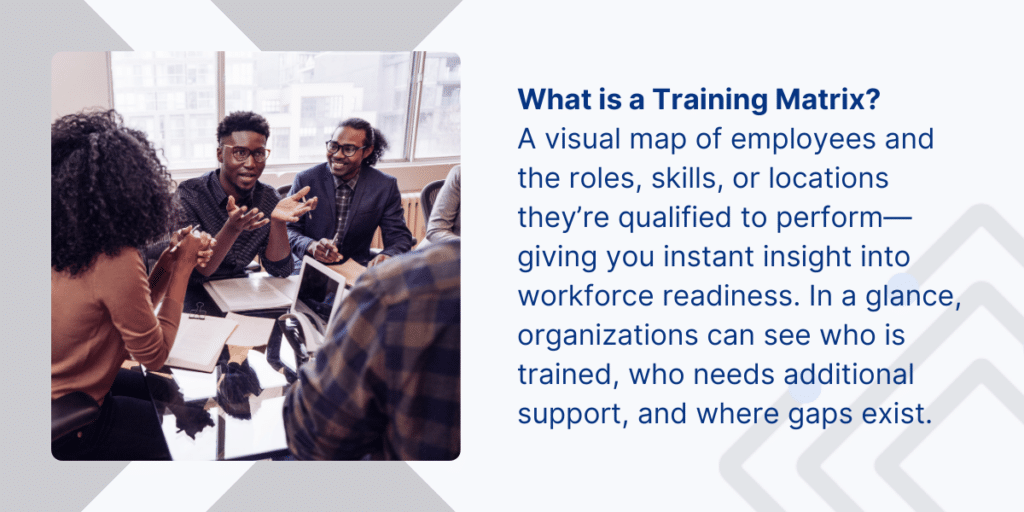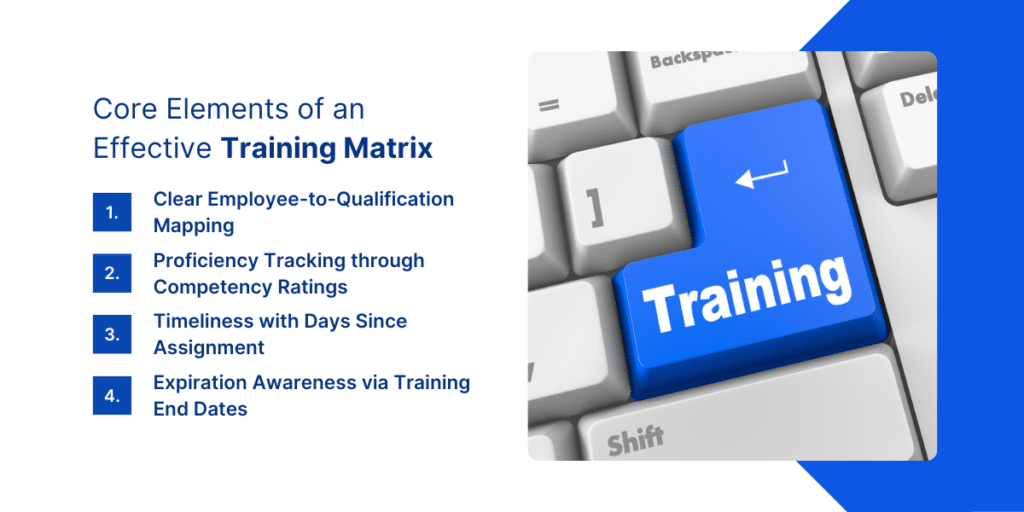As workforce demands grow more complex, organizations need a smarter way to understand who is qualified to do what—and when. That’s where a training matrix comes in. More than a static chart, a well-designed training matrix gives leaders a dynamic, data-driven view of employee skills, qualifications, and training status. When supported by the right system, matrix training becomes a strategic advantage—not just a compliance exercise.
What Is a Training Matrix and Why Does It Matter?
A training matrix visually maps employees to the roles, skills, or locations they’re qualified to perform—giving you instant insight into workforce readiness. At a glance, organizations can see who is trained, who needs additional support, and where gaps may exist. According to Deloitte, 73% of executives expect talent shortages to persist over the next three years, prompting many to prioritize skills over traditional experience. An effective training matrix helps organizations respond with speed, clarity, and confidence.
Beyond talent strategy, the training matrix also supports compliance and operational safety. Clear visibility into training status helps reduce regulatory risk, particularly in industries where qualification tracking is essential to meet safety standards. As the Occupational Safety and Health Administration (OSHA) emphasizes, providing employees with the knowledge and skills needed to perform their work safely is crucial to prevent hazards that could place themselves or others at risk.

Core Elements of an Effective Training Matrix
To be truly effective, your training matrix should go beyond simple lists of qualifications. A static spreadsheet might show who completed training at one point in time, but it can’t provide the depth of insight needed to make strategic workforce decisions. That’s why a high-performing matrix training system—like Indeavor’s qualifications and skills matrix—should include these four essential features:
1. Clear Employee-to-Qualification Mapping
At the most basic level, a training matrix should tell you who is qualified for specific jobs, locations, or skills—and who is not. Indeavor’s “Qualified” criteria offers a binary, yes/no visual that makes it easy to determine employee eligibility instantly. This clarity is critical for daily operations, emergency response assignments, and compliance audits.
Instead of manually reviewing training records, supervisors can rely on a live, up-to-date training matrix to make fast, informed staffing decisions. For example, when backfilling a shift at a critical facility, operations teams can quickly filter for employees who are currently qualified, eliminating guesswork and reducing the risk of assigning untrained personnel.
2. Proficiency Tracking through Competency Ratings
Qualification alone doesn’t always reflect an employee’s ability to perform a task well. Two employees may hold the same certification, but one might have significantly more experience or mastery. Indeavor’s “Competency” matrix addresses this by assigning measurable proficiency levels to each skill or job function.
With this deeper insight, managers can match employees to tasks not just based on eligibility, but on actual capability. This enables smarter task assignments, targeted upskilling, and more effective succession planning. For instance, when assigning team leads for a specialized project, organizations can prioritize those with advanced competency scores, ensuring quality outcomes and faster ramp-up time.
3. Timeliness with Days Since Assignment
Having the right qualification or skill on paper isn’t enough if it hasn’t been used in months—or years. The “Days Since Assigned” feature tracks how recently an employee performed a job or was assigned to a location. This helps organizations identify underutilized talent, maintain skill relevance, and support ongoing qualification requirements (such as annual refreshers or active deployment standards).
Managers can use this insight to rotate employees through roles to keep their experience current or to retrain staff whose time away from a task exceeds a certain threshold. It prevents overloading key personnel—reducing burnout while improving workforce agility.
4. Expiration Awareness via Training End Dates
Certifications and qualifications don’t last forever. When expiration dates are missed, compliance risks skyrocket—and so do the chances of operational disruption. Indeavor’s “End Date” matrix enables organizations to track training and certification validity in real-time, ensuring that expiring qualifications are flagged well before they become a problem.
By integrating expiration data directly into the training matrix, managers can schedule refreshers proactively, avoid costly last-minute scrambles, and maintain a compliant, audit-ready workforce. When paired with alert systems or automated workflows, the end date matrix becomes a key driver of continuous operational readiness.

Strategic Uses of a Training Matrix
The power of a training matrix is in how it’s applied. When integrated into daily operations and long-term planning, matrix training can significantly improve efficiency, compliance, and workforce development. Here are six ways your organization can leverage a training matrix for better outcomes:
Building a Skills Inventory
Use the “Qualified” and “Competency” matrices to create a complete, up-to-date snapshot of employee capabilities across jobs, locations, and skills. This baseline makes it easy to identify gaps in key roles, pinpoint areas of overqualification, and support strategic redeployment. A robust skills inventory ensures the right people are placed in the right roles—both now and in the future.
Training Compliance and Renewal Management
Track certification and qualification expiration dates using the “End Date” matrix to stay ahead of regulatory requirements. Establish consistent review cadences—such as monthly audits—and set up automated alerts to notify training managers of approaching expiration. This proactive approach reduces the risk of lapses, failed audits, or costly operational delays.
Optimizing Workforce Scheduling
Indeavor’s “Days Since Assigned” matrix provides visibility into how recently employees have performed certain tasks or worked at specific sites. Use this data to ensure employees are maintaining current experience and distribute workload more evenly. When paired with competency data, the training matrix enables intelligent scheduling that aligns skill with demand—boosting productivity while reducing burnout.
Identifying Skill Gaps and Training Opportunities
Analyze individual and team-wide competency scores to uncover underdeveloped skills in high-priority areas. Use this insight to design targeted upskilling and cross-training initiatives that address specific organizational needs. Over time, track progress directly within the training matrix to ensure your learning programs are closing gaps and building capacity.
Succession Planning and Career Development
Identify high-potential employees with a combination of strong qualifications and advanced competency levels. Use this insight to support leadership development and build succession pipelines. By aligning individual development paths with organizational goals, you can foster internal mobility, retain top talent, and prepare for future growth.
Enhancing Cross-Functional Collaboration
Standardize matrix reporting templates across HR, operations, and training teams to ensure everyone is working from the same set of data. Regular matrix reviews create opportunities to align on training priorities, coordinate scheduling decisions, and allocate resources more effectively. This shared visibility breaks down silos and promotes a more agile, responsive workforce strategy.

Why Indeavor’s Training Matrix Stands Out
Organizations can no longer afford to manage employee skills and qualifications manually or in silos. Indeavor’s qualifications and skills matrix transforms how companies approach training management—providing not just a snapshot of workforce readiness, but a dynamic tool for planning, decision-making, and strategic execution. It’s more than a reporting tool; it’s a centralized intelligence hub that elevates workforce operations at every level of the organization.
- Comprehensive Visibility: Real-time matrix views for jobs, locations, and skills
- Customizable Criteria: Choose from Qualified, Competency, End Date, or Days Since Assigned
- Integrated Planning: Link matrix insights with LMS or scheduling systems
- Actionable Insights: Support compliance, training, and productivity in a single dashboard
From HR to site supervisors, stakeholders across the enterprise can make better, faster decisions using Indeavor’s configurable matrix training solution. The result? A workforce that’s not only skilled—but agile, audit-ready, and aligned with business goals.
Conclusion
An effective Training Matrix transforms your workforce from a black box into a strategic asset. With visibility into skill levels, qualification statuses, and expiring credentials, your organization can stay agile, compliant, and prepared for what’s next.
By leveraging Indeavor’s skills matrix through the greater workforce management platform, you’ll gain more than insight—you’ll gain the power to act. Make smarter staffing decisions, close skill gaps faster, and build a future-ready workforce that’s trained, tracked, and aligned.
About the Author
Claire Pieper is the Digital Marketing Specialist for Indeavor. In her role, she specializes in crafting strategic and engaging content, ensuring that customers are well-informed. Claire is dedicated to enhancing the customer experience and optimizing the user journey through Indeavor’s solutions. To learn more or get in touch, connect with Claire on LinkedIn.



